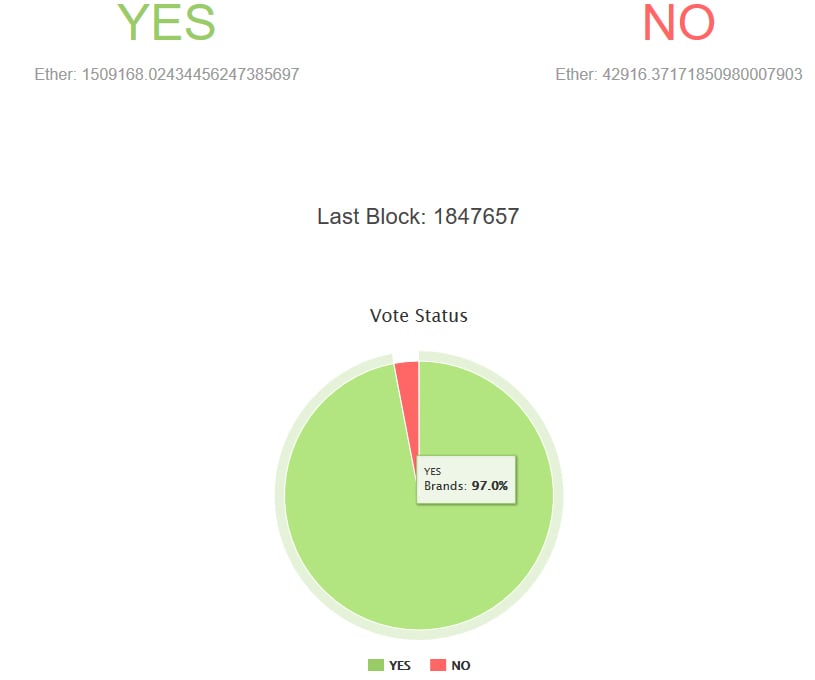Ethereum Reaches Unanimous Agreement to Hardfork

In a historical, decentralized and defining decision, Ethereum holders have unanimously voted in favor of a hardfork to deprive the DAO thief of his ill gains and return the funds to token holders, avoiding a trainwreck just months after ethereum’s release.
Utilizing the blockchain, a transparent and non-gameable voting method shows that out of more than 1.5 million eth, 97%, valued currently at $15 million, are in favor of the fork, with only just above 40,000 eth against.

The unanimous and conclusive decision by ethereum’s community will now turn attention to the implementation of the hardfork which has numerous deadlines, but the latest indications are that it needs to be activated by the 21st of July, just under two weeks. After that date, the situation becomes far more complex.
According to a public statement , the details are still being discussed with numerous proposals on the table. However, Vitalik Buterin, founder of Ethereum, stated that he prefers a proposal which ignores the innocent childDAO ether withdrawals that have been initiated prior to the attack through a split, allows token holders to donate their share of the ExtraBalance to “something”, including themselves, and solves “everything now, without any delay.”
With the community now having conclusively decided that they are to fork, all eyes are on the code. The best indication we were given of when it may be merged was “soon”. Nick Johnson, Software Engineer at Ethereum Foundation stated that developers are busy working on the code as shown by numerous open pull requests related to the hardfork, before adding that “if it seems slow, it’s because we want to be absolutely certain we get it right.” Responding to our question on whether the coding changes were complex, Johnson stated:
“The actual change is fairly trivial – a balance transfer between blocks. All the code around that in order to prevent Bad Things happening adds a lot of complexity. Not to mention very thorough testing. For instance, making sure that any nodes that fast sync after the fork, sync to the correct chain.”
Péter Szilágyi, Software Developer at Ethereum Foundation and one of the main developers of the hardfork code, told CCN.com:
“The consensus logic of the hard fork isn’t too complicated, but networking aspects very much are, which as of now no other client really cared about. Geth has both fast sync and introducing light sync which requires a lot more effort on the networking part to make sure the network partitions cleanly between forkers and non-forkers.
“The soft-fork almost blew the network up because we rushed it and didn’t consider all aspects, I don’t want to make that mistake again. We’re evolving the code slowly, properly covering all possible issues we can imagine with various tests, among other end-to-end network simulations.”
Now that the community has mandated the fork, the code may move faster. Szilágyi states that it can hopefully be implemented in just under two weeks, but whether that will actually be the case remains to be seen. Miners upgraded within hours for the failed softfork and downgraded just as quickly. Businesses too are likely to quickly upgrade, but the 3,500 nodes would probably require at least three or four days.
However, a non-upgraded node would simply be ignored and node operators would probably receive loud red warnings to not use the software and to upgrade immediately. Therefore, with consensus now fully achieved, the July 21st deadline can be met, but whether that will actually be the case is not yet fully clear.
If all goes smoothly, Ethereum may show to the world that it contains safeguards when things go wrong. The first safeguard was the smart contract’s lock in period which trapped the funds and the thief, giving the ecosystem the option to revert the theft. If this was a transaction based hack in bitcoin or ethereum, the funds would have long since dispersed in tens of thousands of addresses, making any enforcement action impossible. As counterintuitive as it is, therefore, this may show that smart contracts are actually safer.
The second safeguard is the community itself which has shown to the world that they treat ethereum as a technology, rather than as an ideological tool, and are therefore willing to intervene in unison when the circumstances are sufficiently exceptional and highly beneficial to the ecosystem and its people. Making ethereum and its community fundamentally different from Bitcoin.
What may, therefore, have been a disaster, may turn out to be a blessing as Ethereum proves itself to be the safest platform where tens of millions are not just burned. Although this event is unlikely to be forgotten as there are many lessons to be learned, unlike hacks of other platforms, it will probably be remembered as a disaster averted, rather than as a tragedy, with everyone from developers, investors, and users standing up to successfully address ethereum’s biggest challenge.
With the hardfork now a foregone conclusion, the community is already beginning to move on. Chronicled just recently announced they have chosen Ethereum to secure high-end sneakers. Devcon2 has just been announced, with Microsoft re-stating their commitment as premier sponsors. Mist browser has just been released. A workshop at Cornell’s IC3 is to be held shortly and, of course, the Blockchain International Week is now just two months away.
Featured image from Shutterstock.